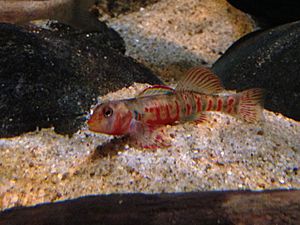Kanawha darter facts for kids
Quick facts for kids Kanawha darter |
|
|---|---|
 |
|
| Conservation status | |
| Scientific classification | |
| Synonyms | |
|
The Kanawha darter (Etheostoma kanawhae) is a small, freshwater fish. It is a type of ray-finned fish that belongs to the darter group. This group is part of the Percidae family, which also includes perches. The Kanawha darter is special because it is found only in certain rivers in the southeastern United States.
Contents
Where the Kanawha Darter Lives
The Kanawha darter is a unique fish found only in the New River area. This river system flows through parts of Virginia and North Carolina in the southeastern United States. These darters like to live in fast-moving parts of small and medium-sized rivers. They prefer areas with gravel or rocky bottoms.
What Does the Kanawha Darter Look Like?
The Kanawha darter is a small fish. It can grow up to about 8.6 centimeters (about 3.4 inches) long. However, most of these fish are usually around 6.5 centimeters (about 2.6 inches) in length.
Habitat and Life Cycle
The Kanawha darter lives in fast-flowing parts of rivers called riffles. These areas have gravel and rubble (small rocks) at the bottom. They can also be found in clear streams and rivers with hard bottoms, whether the water is cold or warm.
Reproduction of the Kanawha Darter
Kanawha darters form breeding groups in shallow water, sometimes only 10 centimeters (about 4 inches) deep. They look for areas with a swift current. They also breed in deeper water, from 30 to 70 centimeters (about 12 to 28 inches) deep. These deeper spots are usually riffles with sand, gravel, and pebbles. The water temperature for breeding is around 19°C (66°F).
Some male darters can start breeding when they are one year old. However, most males and all females begin to breed when they are two years old.
What the Kanawha Darter Eats
The main food source for the Kanawha darter is insect larvae. These are the young forms of insects that live in the water.
How the Kanawha Darter Got Its Name
The Kanawha darter was first officially described in 1941. It was named Poecilichthys kanawhae by a scientist named Edward Cowdenbeath Raney. He found the first known example of this fish in the North Fork of the New River in Crumpler, Ashe County, North Carolina.
See also
 In Spanish: Etheostoma kanawhae para niños
In Spanish: Etheostoma kanawhae para niños


